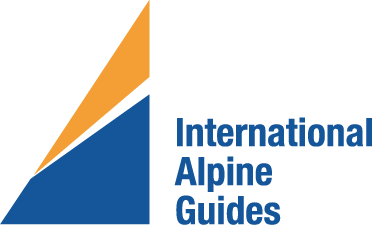EQUIPMENT LIST
Intro to Winter Mountaineering
All of the items listed below are required and It is extremely important to the success and safety of your course that you bring them all. Weather conditions can vary dramatically and you must be prepared!
The items noted with a * can be provided at no cost by IAG/CAG as noted. You must notify us no later than 7 days before your trip of any gear you require from us. Please answer the Gear Request Question in your reservation terminal to advise us of any gear you require from us.
We automatically provide tents for everyone.
Any questions give us a call at: 877-686-2546
Technical Gear
Snowshoes * (We can provide)
Get a pair designed for steeper backcountry terrain with side traction rails
Crampons * (We can provide)
General mountaineering 10-12 point crampons with either straps. Rigid ice climbing crampons are not recommended.
Ice Axe * (We can provide)
The length depends roughly on your height and intended use. For general mountaineering, the axe should hang a few inches above the ground when held comfortably in your hand. Ex. A 5'10" person would have a 70cm axe
Harness * (We can provide)
Look for a lightweight alpine climbing harness.
Helmet * (We can provide)
A climbing specific helmet is required, a bike helmet will not do. There are some very comfortable lightweight helmets on the market now.
Adjustable Ski Poles * (We can provide)
Must have the larger snow baskets... no small trekking baskets.
Avalanche Transceiver * (We can provide)
A simple digital transceiver
Backcountry Shovel * (We can provide)
Lightweight and collapsible designed for avalanche rescue
Other Gear
We provide the tents on all of our trips
Boots* (We can provide)
You need a highly insulated stiff mountaineering boot designed for winter. Either a leather hybrid or double plastic boot. Regular hiking boots and summer mountaineering boots wont do. Also, winter boots that are not stiff soled and that are not designed for climbing will not do.
Backpack * (We can provide)
An internal frame backpack 60-75 liters in size. Ice axe loops on the outside are a good feature
Sleeping Bag * (We can provide)
Rated -5 deg to +10 deg is ideal. Down or synthetic, but down is much lighter and a better performer. 850 fill down performs much better than 650 fill.
Sleeping Pad * (We can provide)
A full length pad is essential for winter camping. Either closed cell or inflatable
Headlamp * (We can provide)
2 One Liter Wide Mouth Water Bottles * (We can provide)
Insulated Mug * (We can provide)
Spoon or Spork * (We can provide)
Lightweight Bowl * (We can provide)
Full Wrap Sunglasses or Glacier Glasses
They must be dark lens full wrap or glacier glasses with side shields. Visible light transmission should be around 6%. By comparison, driving sunglasses have around 20% visible light transmission which is not appropriate.
Clothing
For clothing, we emphasize a layering system in which we put on and take off layers of clothing depending on the outside temperature and the level of activity.
Outer Waterproof Shell Jacket (hard shell) with Hood
A waterproof & breathable shell jacket with no additional insulation sewn in. Lightweight is better.
Outer Waterproof Shell Pant
Must be waterproof & breathable with side zippers.
Climbing Pant (soft shell)
A lighter weight non-waterproof pant that breathes much better than waterproof pants. This is what you will probably be wearing most of the time
Midweight Long Underwear Baselayer
Synthetic or Wool.
Midweight Long Underwear Baselayer Top
Synthetic or wool
Insulating Top Layer - Lightweight
Fleece or wool. This must be thicker than the long underwear top.
Insulated Parka
Down or synthetic fill puffy parka, preferably with a hood. Down is lighter.
Warm Hat
Wool or synthetic
Sun Hat or Ball Cap
2 Pairs Socks
Mid weight to heavy weight wool or synthetic socks. If you normally use liners then bring them also
Insulated Glove - Heavy Weight
Water resistant & wind proof and highly insulated
Lightweight Glove
These do not have to be water resistant. Fleece or soft shell is fine
Calf to Knee Length Gaiters
Other Important Items
Sunscreen
30 SPF or higher
Lip Balm
15 SPF or higher
Toilet Paper
A small amount
Baby Wipes
Lighter
For burning toilet paper
A Couple Small Ziploc bags
Small Personal Kit
Personal medications, Toothbrush, Small amount of toothpaste, blister kit, etc. (the guide will have a full first aid kit)
Foam Ear Plugs
For wind and tent mate noise
Stuff Sacks
For organization
Lunch Food & Snacks
On this trip we will provide breakfast and dinner, but you must bring your own lunch food and snacks for all the days. Bring a blend of protein and carbohydrates. Examples: bagels, cheese, jerky, meats, nuts, dried fruit, chocolate etc. Processed energy bars are also good, but best to limit them and eat whole foods as well. Cheeses and dried meats will keep many days in the backcountry. But mostly you want to bring food you like and will eat while working hard.
For all your gear needs we recommend Moosejaw. They have a huge selection of all the gear you'll need and offer fast free shipping.
We reserve the right to refuse services to any client deemed inadequately prepared at the meeting point.






